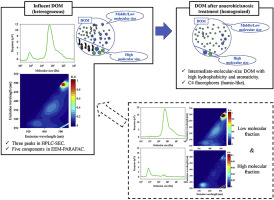当前位置:
X-MOL 学术
›
Water Res.
›
论文详情
Our official English website, www.x-mol.net, welcomes your
feedback! (Note: you will need to create a separate account there.)
Characterization of dissolved organic matter in wastewater during aerobic, anaerobic, and anoxic treatment processes by molecular size and fluorescence analyses.
Water Research ( IF 11.4 ) Pub Date : 2019-12-31 , DOI: 10.1016/j.watres.2019.115459 Kazuhiro Komatsu 1 , Takashi Onodera 1 , Ayato Kohzu 1 , Kazuaki Syutsubo 1 , Akio Imai 1
Water Research ( IF 11.4 ) Pub Date : 2019-12-31 , DOI: 10.1016/j.watres.2019.115459 Kazuhiro Komatsu 1 , Takashi Onodera 1 , Ayato Kohzu 1 , Kazuaki Syutsubo 1 , Akio Imai 1
Affiliation

|
Changes in the characteristics of dissolved organic matter (DOM: the dissolved fraction of natural organic matter) during a series of wastewater treatment plant (WWTP) processes were investigated by using a combination of molecular size analysis and excitation emission matrix (EEM) spectroscopy coupled with parallel factor analysis. The characteristics of DOM were compared following aerobic, anoxic, and anaerobic treatments. Three peaks at about 100,000 Da (high-molecular-size DOM, Peak 1) and about 900-1,100 Da (intermediate-molecular-size DOM, Peak 2; low-molecular-size DOM, Peak 3 as the shoulder of Peak 2) were observed in the distribution of total organic carbon molecular sizes in the influent of the WWTPs. In this study, five fluorescent components (C1 to C5) were identified in the EEM spectra. Molecular size analysis and molecular size fractionation revealed that the C3 (humic-like) and C5 (specific to sewage) fluorophores had intermediate or low molecular sizes. Comparison of the changes of the concentrations of dissolved organic carbon in each reaction tank and investigation of the removal selectivity of each treatment (aerobic, anaerobic, and anoxic) suggested that the heterogenous compounds present in DOM of the influent were homogenized into intermediate-molecular-size DOM with high hydrophobicity and aromaticity, or into C4 fluorophores (DOM-X), during anaerobic or anoxic treatment. DOM-X was able to be transformed or removed by aerobic treatment. The results suggested that introduction of aerobic treatment at the appropriate stage of wastewater treatment or inclusion of physical or chemical treatment should be an effective way to optimize DOM removal.
中文翻译:

通过分子大小和荧光分析表征需氧,厌氧和缺氧处理过程中废水中的溶解有机物。
通过结合分子大小分析和激发发射矩阵(EEM)光谱结合分析和分析一系列废水处理厂(WWTP)过程中溶解有机物(DOM:天然有机物的溶解分数)的特征,研究了其变化。并行因素分析。有氧,缺氧和厌氧处理后,比较了DOM的特性。三个峰分别为100,000 Da(高分子量DOM,峰1)和900-1,100 Da(中分子量DOM,峰2;低分子DOM,峰3为峰2的肩峰)在污水处理厂进水口的总有机碳分子大小分布中观察到。在这项研究中,在EEM光谱中鉴定出五个荧光成分(C1至C5)。分子大小分析和分子大小分级显示,C3(类腐殖酸)和C5(污水特有的)荧光团具有中等或低分子大小。比较每个反应罐中溶解的有机碳浓度的变化并研究每种处理的去除选择性(好氧,厌氧和缺氧),表明进水DOM中存在的异质化合物被均质化为中间分子在厌氧或缺氧处理过程中,具有高疏水性和芳香性的DOM或C4荧光团(DOM-X)。DOM-X能够通过好氧处理转化或去除。
更新日期:2019-12-31
中文翻译:

通过分子大小和荧光分析表征需氧,厌氧和缺氧处理过程中废水中的溶解有机物。
通过结合分子大小分析和激发发射矩阵(EEM)光谱结合分析和分析一系列废水处理厂(WWTP)过程中溶解有机物(DOM:天然有机物的溶解分数)的特征,研究了其变化。并行因素分析。有氧,缺氧和厌氧处理后,比较了DOM的特性。三个峰分别为100,000 Da(高分子量DOM,峰1)和900-1,100 Da(中分子量DOM,峰2;低分子DOM,峰3为峰2的肩峰)在污水处理厂进水口的总有机碳分子大小分布中观察到。在这项研究中,在EEM光谱中鉴定出五个荧光成分(C1至C5)。分子大小分析和分子大小分级显示,C3(类腐殖酸)和C5(污水特有的)荧光团具有中等或低分子大小。比较每个反应罐中溶解的有机碳浓度的变化并研究每种处理的去除选择性(好氧,厌氧和缺氧),表明进水DOM中存在的异质化合物被均质化为中间分子在厌氧或缺氧处理过程中,具有高疏水性和芳香性的DOM或C4荧光团(DOM-X)。DOM-X能够通过好氧处理转化或去除。











































 京公网安备 11010802027423号
京公网安备 11010802027423号